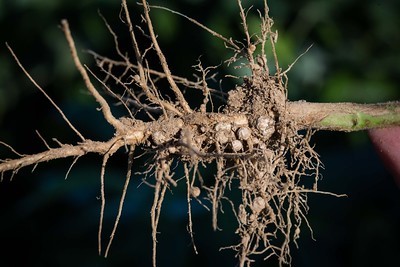Soil health tests are a big conversation topic these days, but there’s a lot of conflicting information out there. Presented by Stacy Zuber, Ph.D., State Soil Health Specialist with USDA Natural Resources Conservation Service, this webinar discusses how soil health tests differ from measuring soil fertility, sampling and handling procedures and how to interpret your results.
Presenter: Stacy Zuber, Ph.D., State Soil Health Specialist with the... Read More →
ILSOYADVISOR POST
Negotiating Nutrient Needs – Soybean Nodulation
June 29, 2020
Nitrogen nutrient requirements for soybeans are much less than they are for corn (total volume/acre). Why is that? Soybeans require every essential nutrient that other row crops do, but they can “produce” their own nitrogen (N). Like a few other plants, soybeans are a legume crop, which means they form a symbiotic relationship with Bradyrhizobium bacteria that use the plant sugars in return for nitrogen.

Credit: United Soybean Board
You may ask why the plant doesn’t just directly use some of the plentiful nitrogen in the air. The answer is because this nitrogen is in a form that is unavailable to the plant. That is where the symbiotic relationship between the bacteria and the plant comes in. Nitrogen in the air is a gas (N2); it is two nitrogen atoms held together very tightly that require energy (sugars) from the plant to be split. The sugars are produced during photosynthesis, and thus translocated from the leaf to the nodule. The bacteria use the sugars as energy for nitrogen fixation. N2 as a result is converted into ammonia (NH3) which then can be used by the plant. The bacteria use the plant’s energy they cannot produce themselves to fix the nitrogen, and in turn provide an available form of nitrogen that the soybean plant can use. Keep in mind that nodule formation will be determined by nitrogen availability in the soil, so if other forms of nitrogen are applied the fixation process will be less necessary.
This is important because nitrogen is essential for many processes that take place within the plant. Nitrogen, broken down into amino acids, is used as important building blocks of DNA and RNA. It is used in the process of photosynthesis and found in ATP, an important molecule for energy.
Soybeans are an efficient plant to say the least. The plant can adapt to a wide range of planting populations, the grain can be used for feed and oils, and their roots can fix their own nitrogen. With nitrogen being at the top of the essential nutrients, its nice to be able to negotiate your own nutrient needs.
Consideration:
- Are you properly supporting nodulation development?
- Are your plant nodules lasting long enough through the season?
- Consider using seed treatments to improve colonialization.
- Consider applying nitrogen preplant to help supply nitrogen to the plant prior to nodulation development.
- When striving for higher yielding soybeans, 75-125 bu/ac, additional nitrogen may need to be applied since the nodulation may not have the ability to fully supply this demand. Note: a soybean plant requires roughly 4-5 units of nitrogen per bushel of soybeans.





Comments
Add new comment